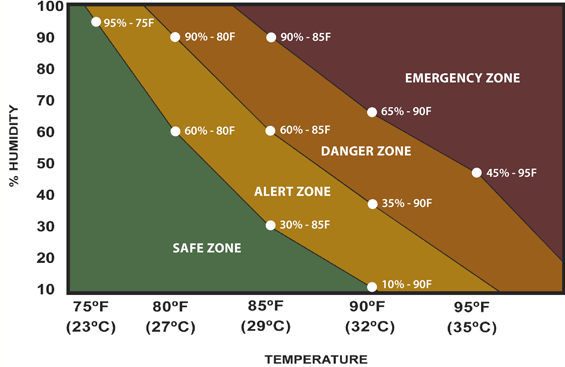Heat Safety Index
The Heat Safety Index will help you make a decision about whether or not outdoor exercise is safe.
- Check your local weather conditions to find the current temperature and humidity reading.
- Look for the temperature along the bottom of the graph.
- Look for the percentage of humidity along the left hand border of the graph.
- Find the place on the graph where these two points come together. The zone that you are in can tell you whether it is safe to exercise outdoors.

To use this scale, look for the air temperature along the bottom of the scale and percentage of humidity along the left-hand border. The intersecting points will indentify one of four zones.
What to do for each heat safety zone
| Safety zone | What to do |
|---|
| Safe Zone | - Exercise as usual.
- Safe to exercise outdoors.
|
|---|
| Alert Zone | - Decrease your exercise intensity (slow your walking pace).
- Watch for signs (such as shortness of breath, increased tiredness).
|
|---|
| Danger Zone | - No outdoor exercise.
- Exercise in an air conditioned environment only.
|
|---|
| Emergency Zone | |
|---|
Be Aware of Air Quality
It is important that you check the weather report for air quality before you exercise outdoors. Smog and air pollution are very serious health concerns. Anyone can be affected especially:
- young children
- the elderly
- those living with heart or lung disease
Smog
Smog can irritate the eyes, nose, and throat. It can also cause coughing, wheezing and chest tightness. Smog is highest in Canada on hot sunny days between noon and early evening, usually between May and September. Do not exercise outdoors during the late afternoon and early evening when smog is at its highest.
Environment Canada provides smog advisories to warn of high smog levels.
See Environment Canada's smog advisories (opens in new window) »
There are two levels of smog alerts.
- A smog watch is issued when there is at least a 50% probability that smog conditions will occur within the next three days.
- A smog advisory is issued when there is a high probability of a smog day occurring within the next 24 hours.
Air pollution
Air pollution happens when many pollutants (substances that are harmful to your health) are in the air. When you check the weather report for air quality, look for the Air Quality Health Index (AQHI). This index tells you the level of common air pollutants.
In Ontario, the range for the index is 0 to 10. The lower the number, the better the air quality. If you live outside of Ontario, go to your local public health website to find out how your area lists the air quality index.
Before you exercise outdoors:
- Check the Air Quality Health Index (AQHI) to know if it is low, moderate, high, or very high risk
- Follow the instructions in the AQHI chart about whether it is safe to exercise outdoors or be outdoors
Air Quality Health Index (AQHI)
| AQHI number | Risk level | What to do |
|---|
| 1 | Low Risk | - Exercise as usual.
- Safe to exercise outdoors.
|
|---|
| 2 |
| 3 |
| 4 | Moderate Risk | - Decrease your exercise intensity.
- Watch for signs.
- Consider rescheduling your outdoor exercise.
|
|---|
| 5 |
| 6 |
| 7 | High Risk | - No outdoor exercise.
- Exercise in an air conditioned environment only.
|
|---|
| 8 |
| 9 |
| 10 |
| Above 10 | Very High Risk | |
|---|
